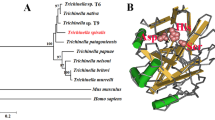Abstract
Angiostrongylus cantonensis is the most common infectious cause of eosinophilic meningitis or meningoencephalitis. A novel gene (AC16) was isolated from a cDNA library of A. cantonensis fourth-stage larvae. The putative 16-kDa protein has 149 amino acids and is homologous to an immunodominant hypodermal antigen (IHA16) from Ancylostoma caninum (identities = 57%). In this paper, we cloned the gene and purified the recombinant Ac16 (rAC16) protein. Real-time quantitative PCR revealed that Ac16 was expressed significantly higher in the fourth-stage larvae and adult worms derived from rats than that in the fourth-stage larvae derived from mice. Moreover, sera from rat (permissive host) infected with A. cantonensis detected Ac16 by Western blot, while sera from infected mouse (non-permissive host) could not. The results implied that Ac16 was related to the parasitic adaptation of A. cantonensis in different hosts and non-permissive host mouse had no circulating antibody to the antigen Ac16 from A. cantonensis and thus might contribute to understanding the mechanism of parasite immune evasion. Furthermore, we evaluated the ability of Ac16 antibody diagnosing A. cantonensis infection by an indirect enzyme-linked immunosorbent assay. The results showed that the Ac16 antibody had a 79.17% sensitivity to rAC16 and 83.33% to crude adult worm antigens (CA) (P > 0.05), while the specificity to rAC16 and to CA were 95.89% and 86.30% respectively (P < 0.05), thus implying that rAc16 may constitute a putative serodiagnostic antigen for Angiostrongyliasis cantonensis.








Similar content being viewed by others
References
Ali AB, Van den Enden E, Van Gompel A, Van Esbroeck M (2008) Eosinophilic meningitis due to Angiostrongylus cantonensis in a Belgian traveller. Travel Med Infect Dis 6(1–2):41–44
Bartschi E, Bordmann G, Blum J, Rothen M (2004) Eosinophilic meningitis due to Angiostrongylus cantonensis in Switzerland. Infection 32(2):116–118
Chen SN (1986) Enzyme-linked immunosorbent assay (ELISA) for detection of antibodies to Angiostrongylus cantonensis. Trans R Soc Trop Med Hyg 80(3):398–405
Chen Y, Swanson RA (2003) Astrocytes and brain injury. J Cereb Blood Flow Metab 23(2):137–149
Chye SM, Chang JH, Yen CM (2000) Immunodiagnosis of human eosinophilic meningitis using an antigen of Angiostrongylus cantonensis L5 with molecular weight 204 kD. Acta Trop 75(1):9–17
Cross JH, Chen ER (2007) Angiostrongyliasis. In: Murrell KD, Fried B (eds) Food-borne parasitic zoonoses. Springer, New York, pp 263–290
Dong Y, Benveniste EN (2001) Immune function of astrocytes. Glia 36(2):180–190
Floden AM, Combs CK (2007) Microglia repetitively isolated from in vitro mixed glial cultures retain their initial phenotype. J Neurosci Methods 164(2):218–224
Intapan PM, Maleewong W, Polsan Y, Sawanyawisuth K, Chotmongkol V (2003) Evaluation of human IgG subclasses antibodies in the serodiagnosis of angiostrongyliasis. Parasitol Res 89(6):425–429
Joshua GW, Perler FB, Wang CC (1995) Orphon spliced-leader sequences form part of a repetitive element in Angiostrongylus cantonensis. Nucleic Acids Res 23(6):1030–1035
Kim SU, de Vellis J (2005) Microglia in health and disease. J Neurosci Res 81(3):302–313
Kittimongkolma S, Intapan PM, Laemviteevanich K, Kanpittaya J, Sawanyawisuth K, Maleewong W (2007) Eosinophilic meningitis associated with angiostrongyliasis: clinical features, laboratory investigations and specific diagnostic IgG and IgG subclass antibodies in cerebrospinal fluid. Southeast Asian J Trop Med Public Health 38(1):24–31
Kliks MM, Kroenke K, Hardman JM (1982) Eosinophilic radiculomyeloencephalitis: an angiostrongyliasis outbreak in American Samoa related to ingestion of Achatina fulica snails. Am J Trop Med Hyg 31(6):1114–1122
Kumar V, Kyprianou I, Keenan JM (2005) Ocular angiostrongyliasis: removal of a live nematode from the anterior chamber. Eye 19(2):229–230
Lan KP, Lai SC (2009) Differences of proteolytic enzymes and pathological changes in permissive and nonpermissive animal hosts for Angiostrongylus cantonensis infection. Vet Parasitol 165(3–4):265–272
Leone S, De Marco M, Ghirga P, Nicastri E, Esposito M, Narciso P (2007) Eosinophilic meningitis in a returned traveler from Santo Domingo: case report and review. J Travel Med 14(6):407–410
Livak KJ, Schmittgen TD (2001) Analysis of relative gene expression data using real-time quantitative PCR and the 2(−Delta Delta C (T)) method. Methods 25(4):402–408
Lo RV, Gluckman SJ (2001) Eosinophilic meningitis due to Angiostrongylus cantonensis in a returned traveler: case report and review of the literature. Clin Infect Dis 33(9):e112–15
Podwall D, Gupta R, Furuya EY, Sevigny J, Resor SR (2004) Angiostrongylus cantonensis meningitis presenting with facial nerve palsy. J Neurol 251(10):1280–1281
Qu ZY, Yang X, Cheng M, Lin YF, Liu XM, He A, Wu ZD, Zhan XM (2011) Enzootic angiostrongyliasis, Guangdong, China, 2008–2009. Emerg Infect Dis 17(7):1335–1336
Rosen L, Laigret J, Boils PL (1961) Observation on an outbreak of eosinophilic meningitis on Tahiti, French Polynesia. Am J Hyg 74:26–42
Slom TJ, Cortese MM, Gerber SI, Jones RC, Holtz TH, Lopez AS, Zambrano CH, Sufit RL, Sakolvaree Y, Chaicumpa W, Herwaldt BL, Johnson S (2002) An outbreak of eosinophilic meningitis caused by Angiostrongylus cantonensis in travelers returning from the Caribbean. N Engl J Med 346(9):668–675
Tu WC, Lai SC (2006) Induction of tumour necrosis factor, interleukin-1beta and matrix metalloproteinases in pulmonary fibrosis of rats infected with Angiostrongylus cantonensis. J Helminthol 80(3):305–311
Wang QP, Lai DH, Zhu XQ, Chen XG, Lun ZR (2008) Human angiostrongyliasis. Lancet Infect Dis 8(10):621–630
Wang QP, Wu ZD, Wei J, Owen RL, Lun ZR (2011) Human Angiostrongylus cantonensis: an update. Eur J Clin Microbiol Infect Dis. doi:10.1007/s10096-011-1328-5
Wu GH (2006) Angiostrongylus cantonensis. In: Tang JQ (ed) Nature-borne diseases. Science Press, Beijing, pp 1182–1189 (in Chinese)
Acknowledgments
We are grateful to Prof. Zhao-rong Lun, Dr. Wen-jun Chen, and Dr. Zheng-yu QU for kindly presenting sera samples. We also thank Prof. Kittisak Sawanyawisuth and Dr. Jeffer for improving the language. The study was funded by grants from the National Basic Research Program of China (2010CB530004).
Author information
Authors and Affiliations
Corresponding author
Rights and permissions
About this article
Cite this article
Li, ZY., Lv, ZY., Wei, J. et al. Cloning and characterization of a novel gene encoding 16 kDa protein (Ac16) from Angiostrongylus cantonensis . Parasitol Res 110, 2145–2153 (2012). https://doi.org/10.1007/s00436-011-2740-6
Received:
Accepted:
Published:
Issue Date:
DOI: https://doi.org/10.1007/s00436-011-2740-6




